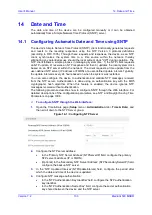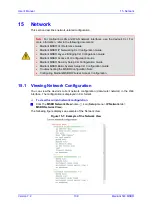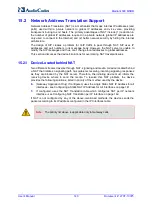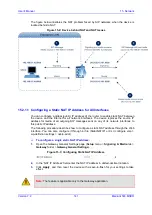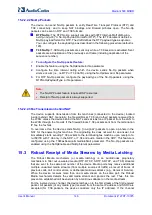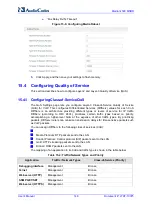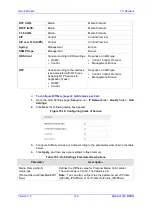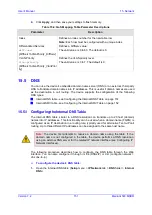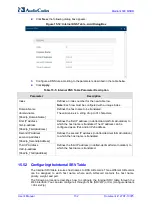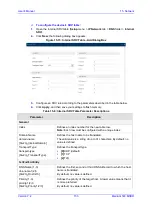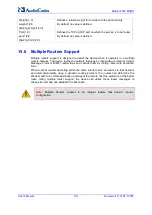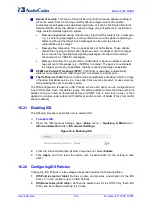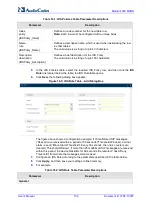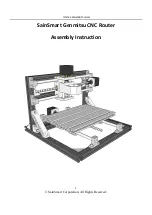
User's Manual
144
Document #: LTRT-10375
Mediant 500 MSBR
device sends responses to the INVITE (to the endpoint) using the the source IP address of
the packet (INVITE) initially received from the endpoint. This is useful in scenarios where
the endpoint is located behind a NAT firewall and the device (for whatever reason) is
unable to identify NAT using its regular NAT Detection mechanism. This feature is enabled
per specific calls using the 'Always Use Source Address' parameter in the IP Groups table
(see Configuring IP Groups on page 333). If this feature is disabled, the device's NAT
detection is according to the settings of the global parameter, 'SIP NAT Detection'
parameter (see below procedure).
To enable the NAT Detection feature (global):
1.
Open the Transport Settings page (
Setup
menu >
Signaling & Media
tab >
SIP
Definitions
folder >
Transport Settings
).
2.
From the 'SIP NAT Detection' drop-down list (SIPNatDetection), select
Enable
:
Figure
15-5: Enabling SIP NAT Detection
3.
Click
Apply
.
15.2.2.2 Media (RTP/RTCP/T.38)
When a remote UA initiates a call and is not located behind a NAT server, the device
sends the media (RTP, RTCP, and T.38) packets to the remote UA using the IP
address:port (UDP) indicated in the SDP body of the SIP message received from the UA.
However, if the UA is located behind NAT, the device sends the RTP with the IP address of
the UA (i.e., private IP address) as the destination instead of that of the NAT server. Thus,
the RTP will not reach the UA. To resolve this NAT traversal problem, the device offers the
following features:
First Incoming Packet Mechanism - see First Incoming Packet Mechanism on page
144
RTP No-Op packets according to the avt-rtp-noop draft - see No-Op Packets on page
146
The figure below illustrates a typical network architecture where the remote UA is located
behind NAT:
Figure
15-6: Remote UA behind NAT
15.2.2.2.1 First Incoming Packet Mechanism
In scenarios where the remote user agent (UA) resides behind a NAT server, it’s possible
that the device, if not configured for NAT traversal, will send the media (RTP, RTCP and
Summary of Contents for Mediant 500 MSBR
Page 2: ......
Page 33: ...Part I Getting Started with Initial Connectivity ...
Page 34: ......
Page 36: ...User s Manual 36 Document LTRT 10375 Mediant 500 MSBR This page is intentionally left blank ...
Page 40: ...User s Manual 40 Document LTRT 10375 Mediant 500 MSBR This page is intentionally left blank ...
Page 45: ...Part II Management Tools ...
Page 46: ......
Page 48: ...User s Manual 48 Document LTRT 10375 Mediant 500 MSBR This page is intentionally left blank ...
Page 115: ...Part III General System Settings ...
Page 116: ......
Page 132: ...User s Manual 132 Document LTRT 10375 Mediant 500 MSBR This page is intentionally left blank ...
Page 137: ...Part IV General VoIP Configuration ...
Page 138: ......
Page 290: ...User s Manual 290 Document LTRT 10375 Mediant 500 MSBR This page is intentionally left blank ...
Page 306: ...User s Manual 306 Document LTRT 10375 Mediant 500 MSBR This page is intentionally left blank ...
Page 380: ...User s Manual 380 Document LTRT 10375 Mediant 500 MSBR This page is intentionally left blank ...
Page 454: ...User s Manual 454 Document LTRT 10375 Mediant 500 MSBR This page is intentionallty left blank ...
Page 455: ...Part V Gateway Application ...
Page 456: ......
Page 460: ...User s Manual 460 Document LTRT 10375 Mediant 500 MSBR This page is intentionally left blank ...
Page 484: ...User s Manual 484 Document LTRT 10375 Mediant 500 MSBR This page is intentionally left blank ...
Page 494: ...User s Manual 494 Document LTRT 10375 Mediant 500 MSBR This page is intentionally left blank ...
Page 625: ...Part VI Session Border Controller Application ...
Page 626: ......
Page 654: ...User s Manual 654 Document LTRT 10375 Mediant 500 MSBR This page is intentionally left blank ...
Page 656: ...User s Manual 656 Document LTRT 10375 Mediant 500 MSBR This page is intentionally left blank ...
Page 741: ...Part VII Cloud Resilience Package ...
Page 742: ......
Page 751: ...Part VIII Data Router Configuration ...
Page 752: ......
Page 753: ......
Page 754: ......
Page 756: ...User s Manual 756 Document LTRT 10375 Mediant 500 MSBR This page is intentionally left blank ...
Page 757: ...Part IX Maintenance ...
Page 758: ......
Page 834: ...User s Manual 834 Document LTRT 10375 Mediant 500 MSBR This page is intetnionaly left blank ...
Page 837: ...Part X Status Performance Monitoring and Reporting ...
Page 838: ......
Page 848: ...User s Manual 848 Document LTRT 10375 Mediant 500 MSBR This page is intentionally left blank ...
Page 852: ...User s Manual 852 Document LTRT 10375 Mediant 500 MSBR This page is intentionally left blank ...
Page 854: ...User s Manual 854 Document LTRT 10375 Mediant 500 MSBR This page is intentionally left blank ...
Page 878: ...User s Manual 878 Document LTRT 10375 Mediant 500 MSBR This page is intentionally left blank ...
Page 880: ...User s Manual 880 Document LTRT 10375 Mediant 500 MSBR This page is intentionally left blank ...
Page 926: ...User s Manual 926 Document LTRT 10375 Mediant 500 MSBR This page is intentionally left blank ...
Page 927: ...Part XI Diagnostics ...
Page 928: ......
Page 950: ...User s Manual 950 Document LTRT 10375 Mediant 500 MSBR This page is intentionally left blank ...
Page 954: ...User s Manual 954 Document LTRT 10375 Mediant 500 MSBR This page is intentionally left blank ...
Page 956: ...User s Manual 956 Document LTRT 10375 Mediant 500 MSBR This page is intentionally left blank ...
Page 958: ...User s Manual 958 Document LTRT 10375 Mediant 500 MSBR This page is intentionally left blank ...
Page 974: ...User s Manual 974 Document LTRT 10375 Mediant 500 MSBR This page is intentionally left blank ...
Page 976: ...User s Manual 976 Document LTRT 10375 Mediant 500 MSBR This page is intentionally left blank ...
Page 977: ...Part XII Appendix ...
Page 978: ......
Page 982: ...User s Manual 982 Document LTRT 10375 Mediant 500 MSBR This page is intentionally left blank ...




